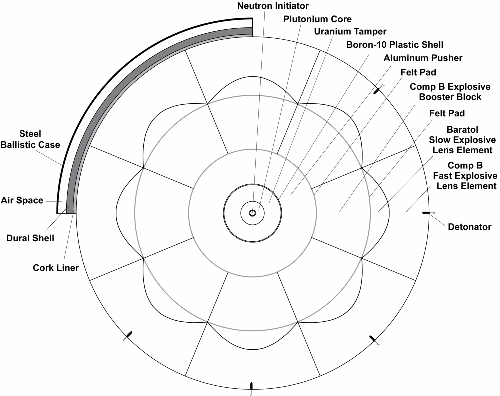Everybody knows “Fat Man,” right? The atomic bomb that was dropped on Nagasaki has been described in some detail in the last few decades. It, just like the “Trinity” “gadget,” was an implosion design bomb that used explosives lenses to compress its plutonium core.

A novel solution to the threat of "dirty bombs"? A "Fat Man" display casing being driven through a Los Alamos car wash. Vouched as legitimate (not Photoshopped) to me over e-mail by a scientist at Los Alamos who claims to have spoken to the truck's driver. The car wash appears to me (via Google Street View) to be the one attached to a "Shamrock" gas station at 1239 Trinity Drive.
Since the implosion concept was first declassified in 1951 as part of the Rosenberg trial, 1 there has been a steady stream of information about the “Fat Man” and “Trinity” bomb designs. The most detailed ones on offer today come from Carey Sublette and John Coster-Mullen, two nuclear weapons design speculators who’ve pinned down a relentlessly detailed, fine-grained vision of what those two nearly-identical weapons were supposed to be:
And yet, after all this time, is there still more to know? More details? How wonkish can you get? Here’s my play for bomb-secret-speculator immortality: there was a very specific, small difference between the cores of the Trinity “gadget” and the “Fat Man” devices. (And the crowd goes, oooo.)
In the Caltech Archives a few years ago, I came across an interview with Robert F. Bacher, conducted by Lillian Hoddeson and Gordon Baym from 1986. Bacher was the head of G-Division at Los Alamos during the Manhattan Project, where “G” stood for “Gadget.” It was essentially the engineering division that coordinated all aspects of the final design and its assembly — so Bacher knew his “Fat Man.”
In the interview, Bacher tells Hoddeson that one of the things they were worried about (“what we were really afraid of”) was that a jet of neutrons would somehow travel between the two hemispheres of the “Gadget” core and somehow cause it to predetonate. In other words, the “Gadget” core was made up of two halves of a sphere of plutonium, and the fear was that if neutrons went along the seam, it would cause the two halves to blow themselves apart too quickly, or something along those lines. For the Trinity “Gadget,” this was mitigated a bit by putting in some gold foil around the neutron initiator, with the idea being that it would stop such a fine, poorly-located jet. He continues:
BACHER: One thing that is not really known and sometimes is not mentioned, while we’re talking about it, is that the bomb that went to Nagasaki …
HODDESON: I was just going to ask. Did that have the hemispheres, the gold foil?
BACHER: No. It wasn’t made the same way.
HODDESON: I see. What were the differences?
BACHER: It had three pieces instead of two. We changed the design. It had a… it was cast with… and you’ll find this in the record, you ought to find this and see, but the one down at Trinity was two hemispheres with a hole in the centre for the initiator. The one that went to Nagasaki was not that way at all. Here is what it would look like with just a hemisphere. What we did was put a ring in here, a ring with a triangular cross section so that the way this fitted was, the cross section in that ring was like that, and it had three pieces to it, and that made a ring in it.
BAYM: That was the Nagasaki one.
BACHER: The Nagasaki; not only that, but the funny part of it is when you look up the patents, you’ll find … this has got a patent on it.
HODDESON: The Nagasaki one.
BACHER: Yes. The little thing there has got a patent on it. 2
I personally am having a hard time visualizing exactly what Bacher is describing, with the triangular ring and all, but it’s pretty interesting, no? (If anyone has any clue, I’m all ears.)
After all this time of saying that the Trinity “Gadget” and the “Fat Man” bomb were essentially copies, here’s a tiny, but significant change — a change that they did without testing it, at that (Bacher says later in the interview that they felt it was not a substantial design change and had high confidence it would still work).
And, of course, I love any reference to the incredible amount of atomic minutiae that was patented during the Manhattan Project. Don’t look for it on Google Patents, though — I’ve searched for it, but it doesn’t seem to have ever been issued, either because 1. it was still classified, or 2. it was declassified but not judged to be worth patenting, or 3. it had no conceivable use other than in an atomic bomb, which puts it in one of the few categories of unpatentable technologies according to Congressional statute.
Ah, “Fat Man,” we thought we knew you? And now we find you’re not quite what we thought. But do we really know you now? How would we know if we didn’t?
- On the declassification of implosion, see Roger M. Anders, “The Rosenberg case revisited: The Greenglass testimony and the protection of atomic secrets,” American Historical Review 83, no. 2 (April 1978), 388-400.[↩]
- Citation: Robert F. Bacher, oral history interview with Lillian Hoddeson and Gordon Baym (3 March 1986), transcript in the Robert F. Bacher Papers, 10105-MS, Caltech Archives, California Institute of Technology, Pasadena, Box 48, Folder 7.[↩]



[…] the basic gun-type design was discussed in the Smyth Report, and the basic implosion design was declassified in 1951 as part of the Rosenberg trial. Why 1960? No particular reason, apparently. The date they were […]
[…] of its implementation — wasn’t declassified after the bombings of Japan. As I’ve mentioned previously, it wasn’t until 1951 (that is, well after the Soviets had demonstrated their own ability to […]
I uploaded a drawing of several possible designs for the plutonium core-
http://www.flickr.com/photos/conqueror_worm/6804092821
According to John Coster-Mullen’s book there was a 3.62” diameter Pu-239 hemispheres with 2.75” diameter jet ring. He got that number from the size of the gold gaskets they took to tinian, but that still doesn’t tell us which way the triangular cross section was facing.
Thanks for writing, Andrew, and for posting those.
I’ve been e-mailing a bit with John and some others on this. I think his current versions include the jet ring as having the triangle “facing outward,” in sense that it looks like an arrow leading out of the core. (So the inverse of yours.) His logic (as I understand it) is that this would stop a neutron jet from being able to escape along a straight line.
I don’t think he has the hole and plug in his current versions.
[…] “gadget” and the Fat Man bomb) was still considered secret at the time (it wasn’t declassified until 1951), so this was a pretty big coup on their […]
[…] It seems to indicate that the plutonium core is in “3 parts,” which jibes with an earlier post of mine (and indicates that the intelligence source really knew what he was talking about, not that we […]
[…] discussed the fact that the Trinity and Nagasaki cores were slightly different in a very old blog post; Trinity was just two hemispheres, whereas Fat Man also included the ring. […]
I would imagine that the problem was prompt neutrons escaping through the gap between the hemispheres and engaging with the core at a distance from the center, causing secondary fission locations that would cause the core to physically expand or explode before the initial chain reaction could complete, lowering the number of reactions.
A ring placed on the outside of the core would be of no benefit, you would need to lens or redirect these neutrons right at the detonator, most likely with the pointy end on the inside.
I would expect the point of the triangle to face inward (arrow pointing to center) for a couple of reasons: 1) its design minimizes any disruption of the core symmetry without additional machining, i.e. the tip of the ring ends in the gap of the core inner diameter and 2) the ring is correctly located and held in place by gravity when assembling the core.